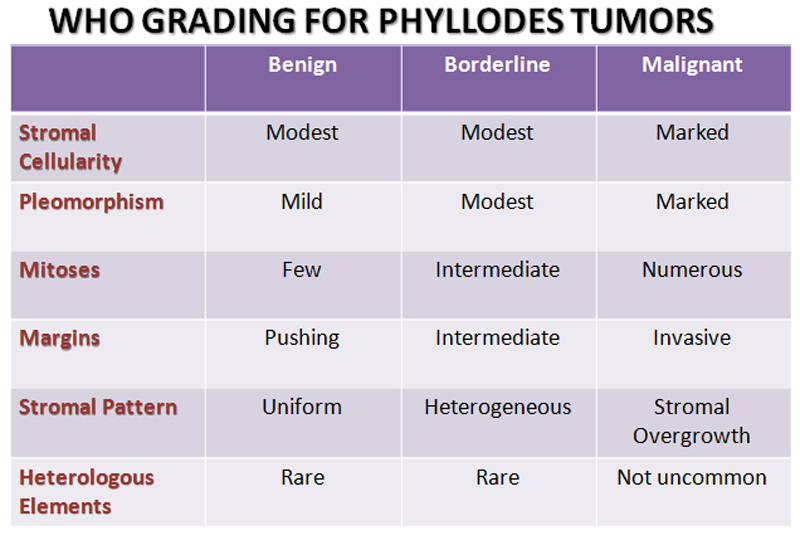
WHO grading of phyllodes is one of the more widely used schema.
Case 1: This is an example of a benign phyllodes. Clefts are lined by a bilayer (epithelium and myoepithelium) surrounded by a cellular stroma. The stroma is the neoplastic portion of the tumor and can range from only slightly more cellular than a fibroadenoma or clearly sarcomatous in the case of malignant phyllodes.
The stroma does not exhibit hypercellularity, consistent with a low grade diagnosis. There can be focal epithelial hyperplasia, but malignant change such as DCIS or invasive carcinoma is extremely rate.
Borderline example: The stroma is more cellular than the low grade/benign designation, and there is some infiltration into adjacent breast adipose tissue.
Case 2: In this borderline example, clefts are lined by a bland bilayer, but there is some variability in stromal cellularity.
Mitotic activity can be appreciated.
The stroma ranges from moderately cellular (seen here) to highly cellular (see above). More atypia is also present.
Case 3: This is an example of malignant phyllodes. The stroma in this field is getting quite cellular.
This field demonstrates numerous mitotic figures. Cellular pleomorphism is moderate.
Gross example 1: of an intermediate grade phyllodes. The surface is fleshy and lobulated with cleft-like spaces.
Gross example 2: Here is an example of a borderline/intermediate phyllodes. The tumor is very large and appears very well-circumscribed. In large tumors, areas of hemorrhage and cystic change can be seen. This particular case demonstrated some features of malignancy.
Gross example 3: This different case is a large phyllodes (23 cm) with large area of central necrosis -- and was histologically compatible with a malignant phyllodes.
Phyllodes tumor is a true neoplasm and its name is derived from the Greek word phyllos for leaf. Grossly, the tumors are well-defined, lobulated with clefts seen on the cut surface, resembling a leaf bud. Most are between 5-10 cm, but can be up to 20 cm. In malignant phyllodes, the margins are ill-defined and the clefts may be less obvious.
Most phyllodes are benign and the stroma consists of plump spindle cells with only mild atypia and minimal mitotic activity. The occasional bizarre pleomorphic figure should not be cause for alarm in absence of other malignant features such as stromal overgrowth and marked mitotic activity.
The WHO (2003 ed) uses the 3-tiered system (benign, borderline and malignant) to categorize phyllodes tumors and help predict biologic behavior. The parameters are: stromal hypercellularity (modest, modest, marked), cellular pleomorphism (modest, moderate, marked), mitosis (few, intermediate, numerous, more than 10 per 10HPF), margins (well-circumscribed/pushing, intermediate, invasive), stromal pattern (uniform, heterogenous/expanded, marked overgrowth), heterologous stromal differentiation (rare, rare, not uncommon).
These lesions are not common (1% of breast tumors) and present as rapidly growing masses in women in their 50s. This is in contrast to fibroadenomas, where the peak age is the 3rd decade. Cases of younger women in the Far East with phyllodes tumor have also been described.
Benign tumors are usually treated by excision. Recurrence rate is 15-20% and depends on the completeness of the excision. For malignant tumors, mastectomy is recommended.
Recurrence increases with the tumor grade, and borderline and malignant types have the potential for metastatic behavior. Up to 20% of malignant tumors metastasize.
→ Most phyllodes are benign, but features of malignancy include an infiltrative margin, cellular atypia, increased mitotic count and a large size.
→ Gains of 1q and 13q losses are associated with borderline and malignant phyllodes (Marick).
• Biphasic : Malignant Phyllodes
Fletcher CDM, ed. Diagnostic Histopathology of Tumors. 3rd Ed. Philadelphia, PA: Elsevier; 2007: 909-911.
O'Malley FP, Pinder SE. Breast Pathology: Foundations in Diagnostic Pathology. Philadelphia, PA: Elvesier; 2006: 118-124.
Tavassoeli FA, Devilee P eds. World Health Organization Classification of Tumours: Pathology and Genetics of Tumours of the Breast and Female Genital Organs. IARC 2003: Lyons, France.
Marick Laé, et al. Phyllodes tumors of the breast segregate in two groups according to genetic criteria. Modern Pathology (2007) 20, 435–444.
